Watch These Peregrine Falcons Become Fierce Parents
Grinnell, a male peregrine falcon, looked up from his nest and started screaming. It was late March and he was taking a turn warming the four eggs he and his partner, Annie, were caring for in their home atop the bell tower at UC Berkeley. A young female peregrine falcon, quite a bit larger than Grinnell, was lurking on the ledge above him. Young peregrine falcons will often come around the site where a pair is already nesting to check it out and plot a possible takeover. She walked right up to Grinnell in the nest and shrieked almost in his face. Grinnell spread his wings wide and swiftly chased her off the tower.
Grinnell had reason to be territorial. He and Annie have been raising chicks on this 307-foot tower since 2017.

Peregrine Falcons Love Cities
Peregrine falcons are the fastest animals in the world: When in hot pursuit of a pigeon or other bird to pluck from midair they can reach 240 miles per hour — faster than a single engine plane. But even these raptor superstars need to settle down with a mate and have some babies to whom they can pass on their love for meat. When they do, they often pick a tall building in a city. Peregrine falcons regularly make their homes in cities across the United States, from New York to Chicago to San Francisco.

“It’s serendipity that cities mimic what peregrines need and are looking for in a habitat,” said bird biologist Sean Peterson, a Ph.D. student at UC Berkeley who helped set up video cameras atop the bell tower last year to monitor Annie and Grinnell and share their comings and goings with the public live on the web. “Cities have a lot of prey animals — pigeons especially. And then they have a lot of fake cliff faces for them to nest on: all these tall buildings. And that gives them protection from predators and lots of places for them to hunt.”
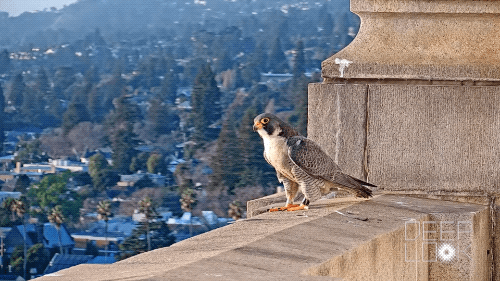
When peregrines nest in the wild, they look for a ledge high up on a cliff.
“There might be a shelf that’s 500 feet off of the ground and 300 feet down from the top, and no mammal’s going to get to it,” said raptor expert Doug Bell, wildlife program manager at the East Bay Regional Park District and, together with Peterson, part of a small team that has been giving Annie and Grinnell a helping hand. “No fisher, no raccoon, no bobcat is going to be able to get to the site.”
Grinnell and Annie have raised four groups of chicks, called clutches, on the bell tower, affectionately known as the Campanile (camp-ah-NEE-lee), starting in 2017. That’s when Bell, Peterson, his wife, bird biologist Lynn Schofield, and volunteer raptor nest monitor Mary Malec discovered Annie nesting at the top of the tower on a wet sandbag and built her a nest out of a plastic tray filled with pea gravel. Gravel is similar to the pebbles or sandy soil they lay their eggs on in the wild and drains well, which allows the parents to keep their eggs warm. Though two eggs were lost by the time nest construction took place, two chicks were born from the eggs that survived.
Annie and Grinnell Put on a Show
Last year the team started operating two video cameras that broadcast the pair’s parenting live through the web. Peterson and Schofield share the happenings in the nest via the Cal Falcons channel on YouTube and on social media. The raising of Annie and Grinnell’s two chicks last year and three chicks this year drew avid fans and tens of thousands of views.

The cameras beam the birds’ behaviors directly to scientists, complementing the information they can gather by patiently watching a cliff all day with a pair of binoculars.
“You start to get a better window into what is going on at the nest,” said Bell.
Researchers can watch peregrines laying their eggs, for example, and they can know more precisely what small birds they feed their young.
This year, Annie and Grinnell cemented their celebrity status by performing in a three-camera, rather than two-camera, reality show, with one video feed documenting their every move in the nest.
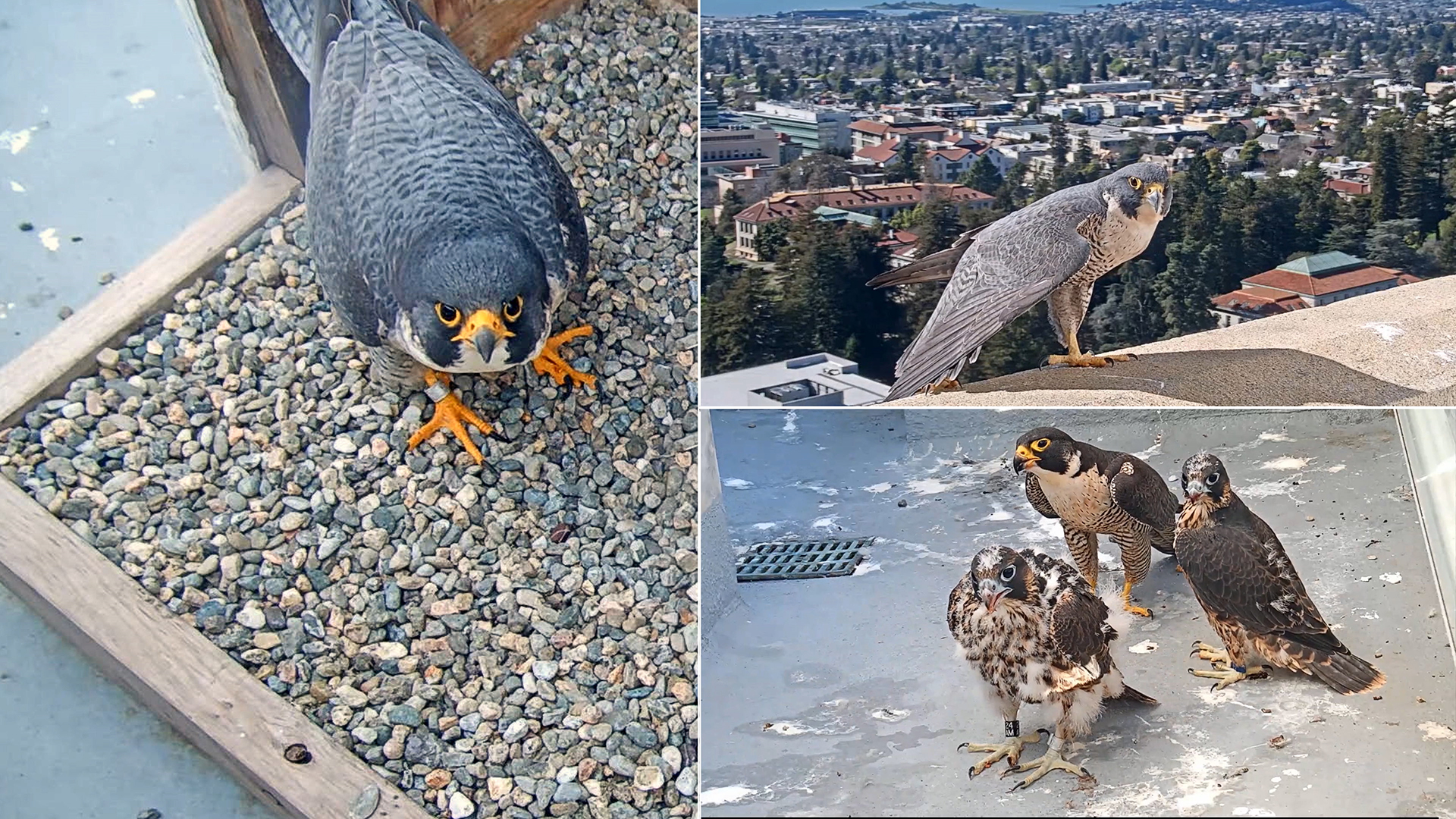
Annie’s first egg plopped right out of her in early March. In the wild, peregrines don’t build a nest of twigs and leaves; they lay their eggs on a ledge in a cliff into which the female has scratched a bowl-shaped depression called a scrape to prevent her eggs from rolling away. Fans had watched Annie do the same thing.
“It’s really cool to see,” said Bell. “She’ll lay with her breast down and she pushes herself into the soil, and you can see her take her feet and she’ll literally scrape the soil out from underneath her and push it towards her tail.”
Detective Work Leads to a Success Story
The four eggs Annie laid in March tell an extraordinary story when you consider that 60 years ago these raptors were on the brink of extinction. In the 1950s and 1960s, they nearly disappeared from the United States.
Scientists had to do some sleuthing to figure out the cause — and they zeroed in on the eggs. Rachel Carson’s book “Silent Spring,” in 1962, raised the specter that the pesticide DDT harmed eggs. With their rusty-red mottled patterns, peregrines’ eggs are so beautiful that private collectors had been taking them from nests as far back as the 19th century. Many of those eggs ended up in museums.
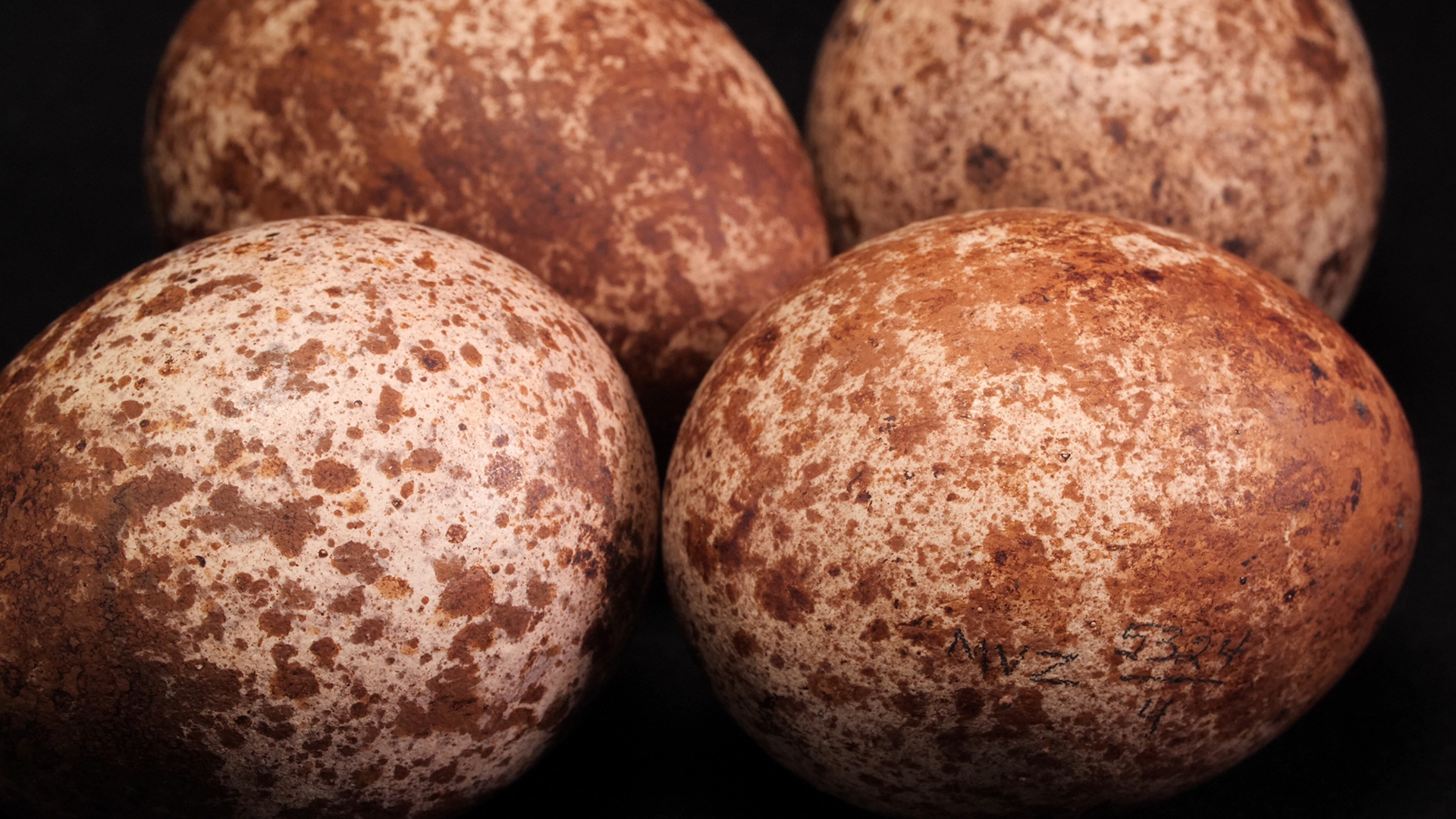
By measuring the calcium content and thickness of eggshells in museum collections, they were able to determine that eggs were thinning and that the culprit was likely DDT.
“Our specimens go back to the late 1800s, early 1900s, so you have this historical material to be able to compare the eggs before and after the introduction of DDT,” said Carla Cicero, curator of birds at the Museum of Vertebrate Zoology at UC Berkeley, one of the institutions whose collections contributed to the research.

The pesticide DDT, used heavily in the 1940s and until 1972 to control mosquitoes, bed bugs and agricultural pests, accumulated in peregrine’s bodies. It thwarted the development of embryos in the eggs. And it reduced the amount of calcium in the females, which resulted in eggshells so thin that they broke when parents sat on them.
“Other times, they were just so fragile that even just a small rock within the nest site or some debris would cause a hole in the egg,” said raptor ecologist Joel “Jeep” Pagel, who as a peregrine falcon specialist for the U.S. Forest Service starting in the early 1980s, and later for the U.S. Fish and Wildlife Service, worked throughout the western U.S. to help their numbers rebound.
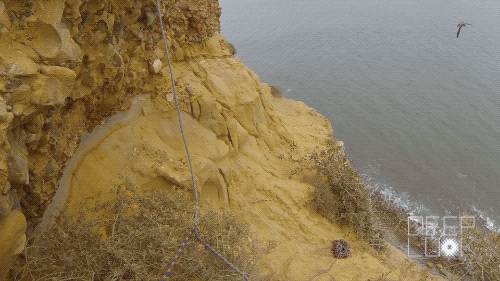
Pagel would rappel down cliffs, removed eggs from their parents and replaced them with plaster of Paris replicas for them to incubate. Alarmed peregrine parents would sometimes attack Pagel, shredding his T-shirt and scratching his back, shoulders and even his face with their large talons. He placed the eggs carefully into an incubator and took them to different research institutions to be hatched in captivity. When the chicks hatched, he returned to nests and placed them with their own parents or with fosters.
“It worked so well that oftentimes the adults were bringing prey items into the nest site to the chicks even before my rope was all the way up the cliff,” said Pagel. “There was never an instance where this type of fostering did not take. The birds were very efficient and they raised those youngsters as if they were their own, and those youngsters fledged and helped increase the population.”
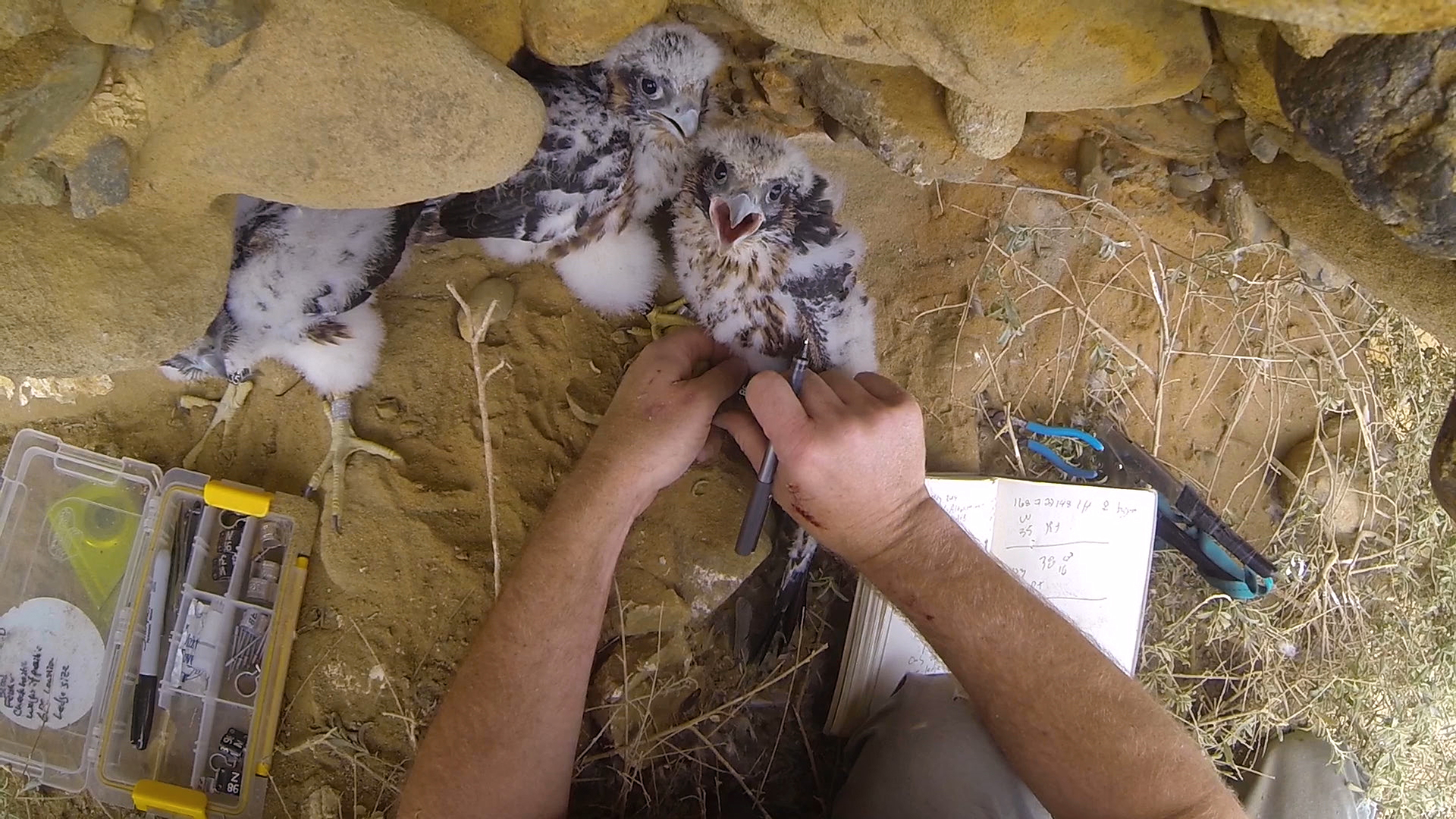
“It’s a real success story,” said Bell.
In 1999, the U.S. government took peregrine falcons off the federal endangered species list, though the raptors continue to be protected in California and elsewhere.
Back at the Campanile nest, it’s Annie who usually sits on the eggs, keeping them at 103 degrees Fahrenheit. Grinnell brings meat to her — pigeons, mourning doves — and takes a turn keeping the eggs warm while she eats.
Of their four eggs this year, one broke, which Bell said could be the result of lingering effects of DDT and its breakdown product, DDE.
“Although it is much diluted, there are still some areas with fairly high concentrations in sediments that may resurface from time to time in our bays and coastal areas,” said Bell. “So it is conceivable that a falcon or fish could still get an occasional dose that would have a physiological effect.”
Noisy Chicks Demand Their Meat
After incubating for about a month, three white chicks hatched in April and they were hungry. In one early feeding caught on camera, Annie fed them tiny bits of meat that she plucked from a pigeon carcass and placed in their mouths. Grinnell hunts and stashes carcasses near the nest for Annie. So when the chicks are hungry, she disappears briefly and comes back with a chunk of meat, which Grinnell has already de-feathered. At mealtime, chicks scream nonstop, making mealtime a raucous affair.
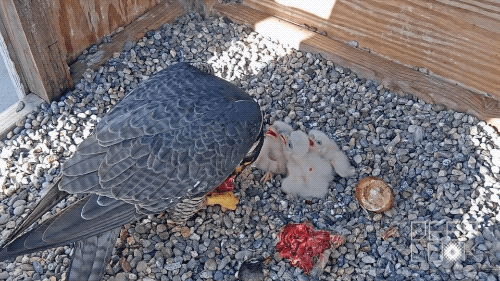
“Whereas with other smaller birds they try to keep quiet and not be noticed by predators, peregrines are in this situation where they basically don’t get penalized for making noise and bringing attention to themselves,” said Peterson. “So they can beg constantly for their parents to give them food.”
And beg they did. Their parents obliged, making sure not to feed them bones or feathers, which chicks can’t digest. But by the time they were 10 days old, the chicks had fully developed a muscular organ called the crop, which crushes bones and feathers into little bits. The proof was a brown ball called a pellet that one of the chicks coughed up on prime time YouTube.

The chicks grew quickly. They went through an awkward phase in which they had white feathers mixed in with the new brown ones. They practiced beating their large wings, fought noisily over food and chased moths together.
And then at the end of May, when they were about 40 days old, they took turns flying off the tower for the first time, a group of noisy fans waiting for them below to cheer them on and make sure they didn’t hurt themselves on the way down. One of Grinnell and Annie’s two chicks born in 2017 died when it hit a window on campus and another chick got stuck inside a building and needed to be rescued, Peterson said.
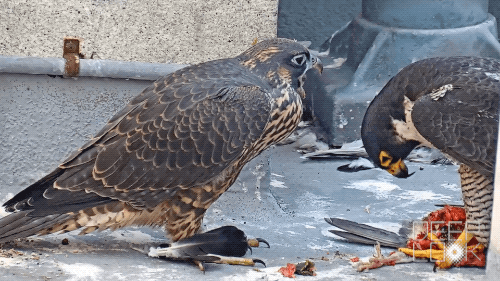
This year, all three chicks fledged successfully. Because each one has been given a small band with a visible ID number, bird watchers can report sightings of the young and follow their journey. One of Annie and Grinnell’s 10 offspring, a female called Lawrencium, born in 2018, is known to be living on some prime Bay Area real estate: Alcatraz.
“She just had her first chicks this year,” said Peterson. “So Annie and Grinnell, we know, are grandparents now.”
